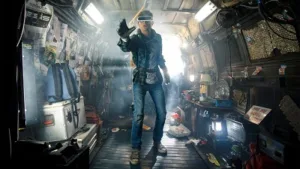Educators using VR in schools certainly don’t shy away from their histrionics. Take for example some of the VR-related titles at a recent national ed-tech conference:

OMG with VR
Oh, the Places We Will Go
Jump on the Virtual Reality Tour Bus
Geekbumps and Nerdgasms
Embrace the Power
While You Were at Work, Your Kid Was on Mars
I’ve also noticed a decided interest on the part of educators in the dystopian novel “Ready Player One” by Ernest Cline, recently brought to the big screen by no less a force than Steven Spielberg. It seems every national ed-tech conference now offers a session or two with the catchphrase “Ready Player One” in the title. For example, this year SXSWedu featured a conference session entitled “Ready Player One? How VR Will Transform the Class.” (Again, notice the sensational title.) I
In educational organizations, book studies are springing forth, focused on the excitement surrounding virtual reality in general, and this new movie, in particular. And in talking to a number of national ed-tech leaders, I get the sense that it is their firm belief that the new Spielberg epic will somehow launch virtual reality forward as a major force in how we educate children, as voraciously represented in the Oasis, the expansive virtual world experienced by nearly everyone in our miserably evolved near future.
 Laying aside their grandiloquence for now, I’m not sure these blustery educators have read the novel “Ready Player One” cover to cover. If they had, they might not have referenced the book or the film in their presentation titles so eagerly. You see, this now reinvigorated piece of young adult literature initially and ultimately rejects the dehumanization, the isolation, and the artificiality of life and learning in virtual reality, as represented by the virtual reality universe known as the Oasis. . Hold on a minute. That can’t be true, can it? Yes it can. (Be aware, spoiler alert!) You see, in chapter twelve, Og Morrow regretted,
Laying aside their grandiloquence for now, I’m not sure these blustery educators have read the novel “Ready Player One” cover to cover. If they had, they might not have referenced the book or the film in their presentation titles so eagerly. You see, this now reinvigorated piece of young adult literature initially and ultimately rejects the dehumanization, the isolation, and the artificiality of life and learning in virtual reality, as represented by the virtual reality universe known as the Oasis. . Hold on a minute. That can’t be true, can it? Yes it can. (Be aware, spoiler alert!) You see, in chapter twelve, Og Morrow regretted,
“ …the Oasis had evolved into something horrible. It had become a self-imposed prison for humanity, […] a pleasant place for the world to hide from its problems while human civilization slowly collapses primarily due to neglect.”
In the final chapter, Halliday bemoaned
“…as terrifying and painful as reality can be, it’s also the only place where you can find true happiness. Because reality is real. Do you understand?”
Halliday also admonished
“Don’t make the same mistake I did. Don’t hide in here forever.”
And as a fitting grand statement in the book’s final and most powerful sentence, the protagonist Wade Watts realized
“It occurred to me then that for the first time in as long as I could remember, I had absolutely no desire to log back into the Oasis.”
Although it is fair to say that Spielberg did a good job in the film of obscuring this obvious refrain, this messaging cannot be ignored in the book itself. The epic film adjusted the original content so as to establish “quiet days” for the Oasis on Tuesdays and Thursdays, so that the VR-addicted world could rediscover relationships, love, and the beauty of nature, but still remain promotive of VR as a technology. (Incidentally, I enforce “quiet days” in my online classes at the university, so that students can reclaim some small and comforting moments of their crazy-busy lives.)
Eric Hoffer once famously observed, “Every great cause begins as a movement, becomes a business and eventually degenerates into a racket.” I am afraid that the film has perpetuated the racket. Although I remain bullish on VR in education, I favor a more cautious and critical approach towards inching VR forward in classrooms. And I wouldn’t be tying my VR wagon to the Ready Player One star, for starters. It’s mixed messaging. –Len Scrogan

